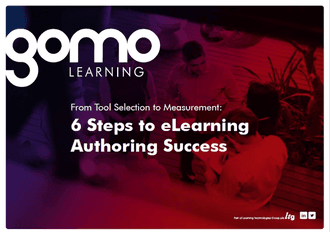How to introduce a new eLearning authoring tool: Your first 3 steps
This post presents an extract from ‘Introducing a New Tool’ the third chapter of our most recent ebook From tool selection to measurement: 6 steps to eLearning authoring success. Here, we cover the first three of our six steps designed to quickly and efficiently transition you to a new platform—authoring or otherwise.
It’s only human nature to be attached to old methods and tools. We’re always aware of the time we’ve already invested in learning the journey, layout, and processes that have become comfortable to us. So when a new piece of learning software is introduced, people can be slow to embrace it.
The benefits of moving to a new piece of software are likely to be obvious to the team who went through the process of purchasing it. Nevertheless, you still have to be prepared to do some work to demonstrate those benefits to the wider business. In this chapter, we discuss the steps that will help you create the best possible first impression, and keep your content creators and learners from falling back into old habits.
Step 1: Ensure your needs have been mapped
As Gavin talks about in chapter 1, mapping your needs—dictated by your audience, your output, and your ecosystem—is an important first step to discovering the right tool. This foundational work is also important when it comes to introducing it. Share your mapping insights with your provider, and expect them to do their own work to understand your situation and requirements. Particularly look out for and test:
- Vendor understanding of your audience and use-case
- Agreement on what final outputs will look like
- Your requirements. If you have multiple vendors, work collaboratively to establish channels of engagement. Getting everyone on the same page creates a much better experience for everybody.
Unmapped needs can be disastrous when introducing new software. They lead to unmanaged expectations of how things will work, frustrations with the tool and unnecessary time pressures. These kinds of negative first impressions are difficult to turn around.
Step 2: Have a champion for the tool
Your champion is an expert in the software who, alongside their normal job at your organization, works to improve and support positive behavior through the onboarding period and beyond. The champion becomes a point of contact on both sides of the arrangement. They’re both the first point of contact for staff who need support with the software, and the point of liaison for the vendor to provide further information.
A product champion is typically:
- An account owner
- Someone with a higher level of technical ability
- Good at communicating technical findings to others
- A manager or supervisor of a team.
From their position, a champion can cascade knowledge throughout the team. Over time, they can also work to create further champions by passing on knowledge.
Taking ownership of support for the simple and intermediate functions of the tool in-house in this way is a very efficient way to work. If users have an issue, they can go to the champion (or champions) for an answer. If the champion doesn’t have an answer, they can escalate (and potentially catalog several new problems) to the provider’s own support channels.
Obviously, if you’re a single license user, you become the champion by default. But it’s worth bearing the above in mind if and when usage of the software expands.
Step 3: Account for staff’s attachment to old software
It’s absolutely possible to support staff who’re attached to legacy software—the key word here is ‘support’. In collaboration with your vendor, you should create a custom onboarding process for your learners that’s sensitive to how staff currently interact with their existing solution. In particular, ensure that:
- All tasks can be brought forward and mapped to the new software so that users don’t feel uncomfortable
- Your users feel they’re going to be able to achieve or exceed what they were doing before.
Of course, if the tool you’re trying to onboard has similar processes that will be immediately familiar to your users, that’s a distinct advantage. However, don’t prioritize this similarity over finding a solution that allows you to achieve new and improved outputs.
Continue reading
This is only the first half of our advice on introducing a new tool to your organization. Steps 4 through 6 of this chapter cover some measures you should plan to have in place for the first few weeks of your implementation. We cover how to best showcase the benefits of the new tool and the importance of giving everyone enough time to learn it. Finally, we look at why you should measure the success of your introduction.
In the remaining chapters of the ebook, we also cover how to:
- Define your needs and lay the groundwork before purchasing a new learning tool
- Work to your budget and build content that secures budget increases
- Create high-quality, effective learning content
- Review your content in line with best practice in order to avoid common oversights
- Track the content you launch and use data to refine it
Download the ebook today using the form below.
About the author: Simon Waldram
As Product Manager at Gomo, I’m passionate about delivering value at every interaction and to increase sustainable proven value for our customers and business.
I have extensive experience of working within both the commercial and educational sectors, and approach all projects with a strategic mind.
This combination of education and commercial experience has enabled me to stay at the leading edge of emerging technologies to ensure that customers are provided with a framework for success.

